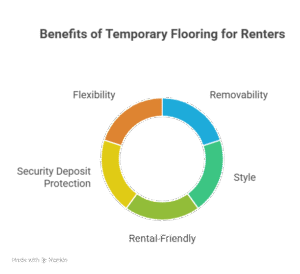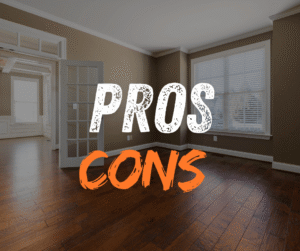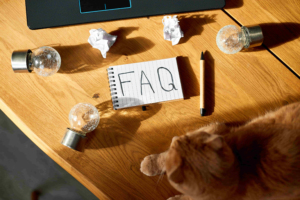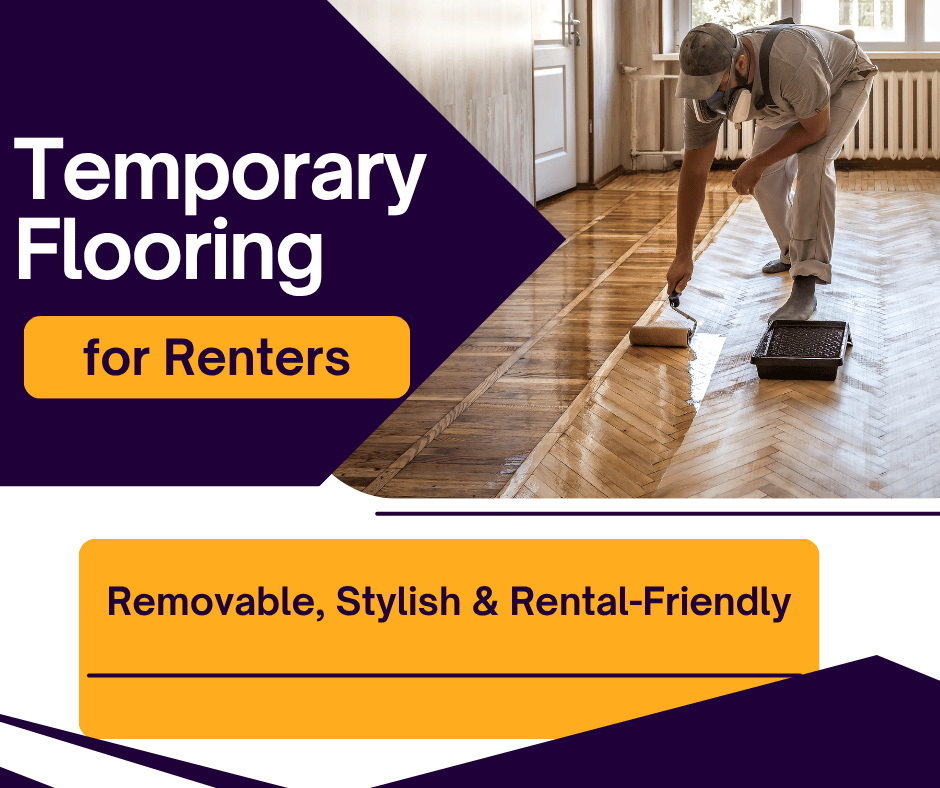You don’t have to put up with old, broken, or simply unsightly flooring when you move into a rental. There are renter-friendly flooring options that look fantastic and are simple to remove when it’s time to move out, regardless of whether you’re dealing with cold concrete, old carpet, or vinyl that has seen better days.
We’ll go over the top temporary flooring options for renters in this guide. Everything you need to revamp your area—without jeopardising your security deposit—is available, including inexpensive tiles and peel-and-stick vinyl.
Quick Comparison Table
| Flooring Type | Cost/Sq Ft | Installation | Lifespan | Removal |
| Peel-and-Stick Carpet Tiles | $1–$3 | Easy | 1–2 years | Easy, no residue |
| Vinyl Floor Decals/Tiles | $1.50–$4 | Very Easy | 2–3 years | Peel off easily |
| Foam Floor Tiles | $1–$2.50 | Snap-together | 1–2 years | Lift & store |
| Floating Vinyl Plank | $2–$5 | Click-in | 3–5 years | No damage |
| Composite Decking Tiles | $4–$6 | Interlocking | 5+ years | Fully removable |
| Artificial Grass Tiles | $3–$5 | Interlocking | 2–4 years | Removable |
Types of Flooring That Are Renter-Friendly

Let’s examine the most widely used temporary flooring options for tenants, their applications, and their benefits.
1. Carpet tiles that peel and stick
These are low-pile carpet squares with detachable adhesive backing. They are ideal for living rooms and bedrooms where foot comfort is important. Simply replace the tile if it becomes stained. These are soft, fashionable floor tiles that are suitable for renters.
- Peel-and-stick tiles and vinyl floor decals
Do you want a modern tile look without having to install it permanently? Vinyl floor tiles that are easy to peel and stick are the best option. They adhere directly to tile, concrete, or old linoleum floors and remove easily when you’re finished. Excellent for entryways, bathrooms, and kitchens.
- Tiles with foam flooring
These interlocking tiles are soft, lightweight, and available in dozens of colours; they are frequently used in playrooms and home gyms. They look fantastic over existing vinyl, concrete, or hardwood floors. Simple to replace and clean.
- Laminate or floating vinyl planks
You don’t need glue or nails to install these click-in planks over your current flooring. They are among the options for temporary flooring that look the most realistic. If the carpet is low pile, you can even float vinyl planks over it.
- Outdoor tiles or composite decking
Composite decking tiles are easy to assemble and can create comfortable and livable outdoor spaces for patios, balconies, and concrete areas. They won’t harm the current concrete base and are long-lasting and water-resistant.
- Artificial grass tiles
Do you miss your backyard because you live in an apartment? These tiles are ideal for balconies because they resemble real grass. Without the need for glue, they snap together and rest on concrete. An attractive outdoor tile floor option that is affordable for renters.
How to Put Up Temporary Flooring (Do It Yourself)
Here’s how to ensure a seamless process:
Low-pile carpet is the ideal surface for floating vinyl planks.
- Install a thin underlayment or moisture barrier.
- Click each plank into position.
- Only a cutting knife is required.
Flooring that peels and sticks
- Make sure your base floor is completely clean.
- Commence at a straight wall or the middle of the space.
- Tiles should be peeled, compressed, and smoothed down.
- Trim edges with a blade or scissors.
Tiles that interlock (outdoor or foam)
- Like a puzzle, snap the tiles together.
- No tape or glue is needed.
- When moving, lift and reuse
The Carpet Tape Method
- Excellent for runners or carpets
- Make use of detachable double-sided carpet tape.
- Prevents corners from curling up
Pros and Cons of Renter-Friendly Flooring

| Feature | Pros | Cons |
| Easy Installation | No tools or pros needed | May take time for large areas |
| Affordable Options | Great for tight budgets | May not last as long |
| Removable | Won’t harm floors underneath | Must be cleaned before removal |
| Stylish Choices | Modern wood, tile, and carpet looks | Some options look less realistic |
Maintenance & Removal Tips
- Always test a small area before full install
- Use gentle cleaning (no bleach or harsh scrubbing)
- When removing, peel slowly and clean with mild soap
For foam or interlocking tiles, vacuum or mop and store flat
Budgeting: What You’ll Spend
- Small Room (100 sq ft): $100–$300 depending on material
- Large Room (200–300 sq ft): $200–$800
- Tools: Most materials need no tools; scissors, a knife, or measuring tape may help
- For savings, search online for kits or bundles.
Advice for Renters
- Renters should speak with their landlord before installing anything because some leases forbid even detachable modifications.
- Check your lease for any changes.
- Take before and after pictures of your floor for documentation.
By taking these simple actions, you can prevent losing a portion of your deposit.
Ideas for Outdoor-Friendly Flooring
Remember your concrete patio, porch, or balcony!
- Composite decking tiles are weather-resistant and have a wood-like feel.
- Artificial grass tiles make outdoor lounging more enjoyable and comfortable.
- If the area is covered, foam tiles can be used.
These are excellent illustrations of how temporary flooring over concrete can change a room.
Safety and Environmental Aspects
- Seek out low-odor and VOC-free materials.
- Select kid-friendly and pet-safe options.
- Nowadays, a lot of foam and vinyl products are recyclable and BPA-free.

Commonly Asked Questions
Can peel-and-stick flooring damage my original floor?
Not when placed on spotless surfaces and taken out with care. Test first, always.
Is temporary flooring waterproof?
Certain composite decking options and vinyl tiles are water-resistant. Moisture may be absorbed by foam tiles.
Is it safe to use on concrete floors?
Yes! Over concrete, many products make excellent temporary flooring. Peel-and-stick, foam, or outdoor tiles are all suitable.
Which floor tile is best for renters?
The most popular types are carpet tiles or peel-and-stick vinyl. It looks fantastic and is simple to apply and remove.
What is renter friendly flooring over carpet?
Renter-friendly flooring over carpet includes temporary options like peel-and-stick tiles (vinyl, carpet, foam), sheet flooring, and area rugs. Interlocking planks (LVP, laminate) can also be used, often requiring a plywood layer over high-pile carpet for stability.
How to temporarily cover carpet in a rental?
You can temporarily cover carpet using canvas, interlocking peel-and-stick tiles (vinyl, carpet, foam), or floating planks like LVP or laminate. For plush carpets, a 1/4″ plywood layer is recommended under floating planks for stability. Area rugs offer the simplest temporary solution.
What is the best floor covering for a rental property?
Luxury Vinyl Plank (LVP) is widely considered the best floor covering for rental properties. It offers an excellent balance of durability, water resistance, affordability, and ease of maintenance, making it ideal for high-traffic areas.
Can I lay laminate flooring over carpet?
Experts generally do not recommend laying laminate flooring directly over carpet because it can cause instability and trap moisture. However, you can install it over sturdy, low-pile commercial carpet or add a 1/4″ plywood layer over plush carpet for stability.
You don’t have to put up with floors you detest just because you’re renting. You can add a personal touch to your space with contemporary, renter-friendly flooring options without upsetting your landlord or forfeiting your deposit.
Enjoy your newly renovated living area while exploring and experimenting. Even if it’s only temporary, you deserve a home that feels like yours.



